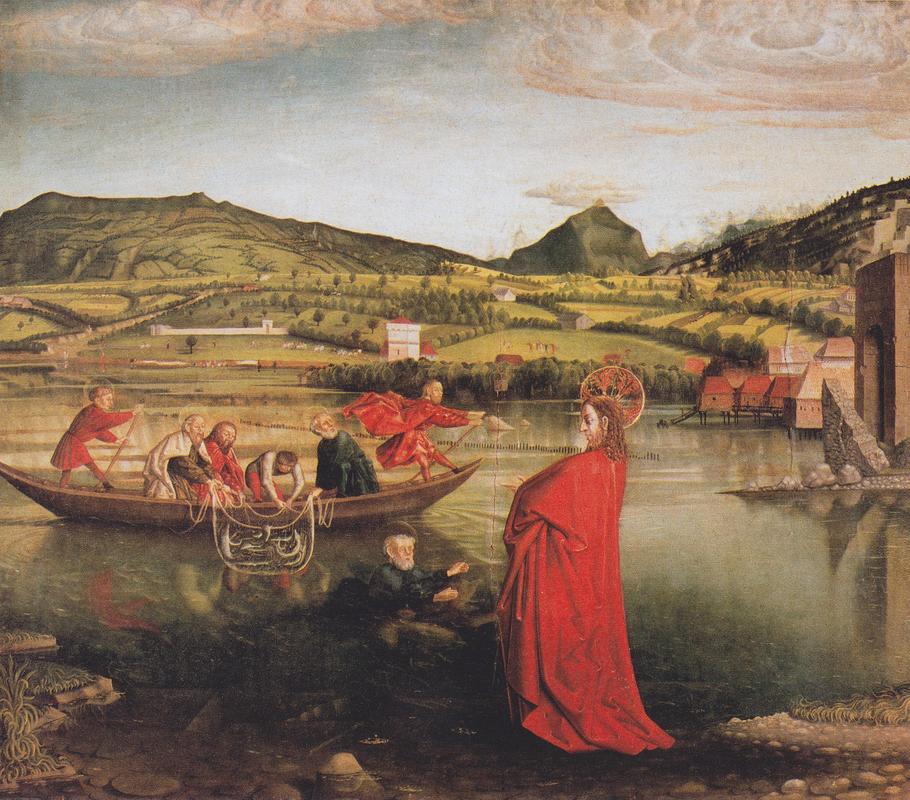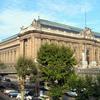More about The Miraculous Draft of Fishes

Contributor
In the same century as Columbus's accidental visit to the Caribbean, Konrad Witz painted a picture of a landscape, his Miraculous Draft of Fishes, the title scholars coined for an external part of a cathedral altarpiece.
When you do something before anyone else does it, sometimes everyone rejects you, sometimes everyone loves you, and sometimes you get the Konrad Witz treatment, and everyone ignores you for 450 years when you finally become an important genius. In this case, the critical big break came from a writer named Burckhardt in 1901. Having dug the dusty Witz from the bottom of the Clearance section, Burckhardt "discovered" Witz, and it became as if Witz's work was Buckhardt's creation. Although, decades later, art historians would agree that Witz was the first European landscape painter, Burckhardt was more of a nineteenth-century neighborhood blogger, investigating the history of art from the Swiss city of Basel, which you can also spell as Basle, depending on your mood. Witz was a citizen of Basel and a member of the painter's guild.
We don't know what the original installation of The Miraculous Draft of Fishes looked like when Witz finished it five centuries ago because it belonged to the exterior wing of the altarpiece of a Geneva cathedral that no longer exists. The other side of the altarpiece was an image of St. Peter bustin' outta the pen and the centerpiece is lost. The Miraculous Draft of Fishes shows Peter, the first Pope, trying to emulate his master's walking-on-water trick, with no success. This could have been a hidden message from Witz's patron to Rome: "stay outta our bidness, we got dis." Other scholars imagine that the altarpiece, with its missing middle, was an attempt to unify bickering factions of Christianity by agreeing that Peter was a swell guy, even though he couldn't duplicate the magic of walking on water.
The Miraculous Draft of Fishes is like a greatest-hits collection of the Greek New Testament, citing stories from Matthew, Luke, and John, and transporting them to the familiar locale of Lake Leman, with the Alps overhead. In the area of landscape, Witz was an innovator, and he also innovated the artistic "surgery" by which European artists, translators, preachers and writers have brilliantly, over the centuries, amputated Biblical stories from their Middle Eastern origin and grafted them onto the European subcontinent. Is it just the "home sweet home" effect of seeing one's own land in one's sacred stories, or are there multiple levels of motivation behind this cultural surgery?
Sources
- Burckhardt, D. Festschrift zum Vierhundertsten Jahrestage des ewigen Bundes zwischen Basel und den Eidgenossen 13. Juli 1901. Basel: Historische und Antiquarische Gesellschaft, 1901.
- Kleiner, Fred S. Gardner's Art through the Ages: Backpack Edition, Book D: Renaissance and Baroque. Boston: Cengage, 2015.
- Lörzing, Han. The Nature of Landscape: A Personal Quest. Rotterdam: 010 Publishers, 2001.
- Smith, Molly Teasdale. "Conrad Witz's Miraculous Draught of Fishes and the Council of Basel." The Art Bulletin 52 (1970): 150-156.
- Stokstad, Marilyn. Art History: Fourteenth to sevententh century art. Upper Saddle River, NJ: Pearson Prentice Hall, 2008.
Featured Content
Here is what Wikipedia says about The Miraculous Draft of Fishes (Witz)

The Miraculous Draft of Fishes is a 1444 oil on wood panel painting by the Swabian artist Konrad Witz, on view in the Museum of Art and History (Musée d'Art et d'Histoire) in Geneva, Switzerland. Witz was the first artist to be recognized for incorporating large landscapes in paintings with large amounts of detail. The landscape has a panoramic view of Lake Geneva and was a significant accomplishment for Northern Renaissance Art.
Originally part of a now dismantled altarpiece known as Peter's Altar Table, the panel depicts the miraculous catch of 153 fish as reported in the Gospel of John and shows a scene of the disciples, who had been fishing at the edge of a lake, recognising the stranger who had called out to them from the shore as the resurrected Jesus. Peter is shown wading toward Jesus to greet him. In this painting Witz takes the revolutionary step of moving the scene from the biblical Sea of Galilee to his local area, around Lake Geneva. With this move, Witz was able to base his rendering of the far landscape on his own observation of actual topographical features rather than rely on imaginative interpretation as earlier artists did. He further brought the landscape to the fore of his work; here the range is not simply a footnote seen through a window or detail visible beyond a crucifixion scene. The painting is renowned for its naturalistic representation of the Graian Alps and the snow-capped peaks of Mont Blanc and Le Môle seen in the distance. In this regard the work is the earliest known faithful portrayal of a landscape in European art history.
Detailed landscapes had already been portrayed by Early Netherlandish painters such as Jan van Eyck, and their characteristic attention to surface textures and rendering the depth of the receding landscape held strong influence over Witz. These earlier works were neither based on actual geographical areas, however, nor upon the careful observation evident in this work. In its innovation, the panel is analogous to Hans Bornemann, at the time working in Lüneburg, who also adapted and greatly advanced the Netherlandish method when he began to paint, for the first time, cityscapes that gave a true account of all of the visible features, and not just the most important buildings.

The painting can be seen as close study of the optics of reflection and the manner in which the form and appearance of objects is distorted reflected on water's surface. The buildings and rocks to the right are reflected, as are the coloured clothes of the men hauling a net in the small boat. In the foreground the water is so transparent the bed of the lake can be seen, while at the far end of the lake the tone of the water surface dissolves into a silvery expanse. Only the figure of Christ standing at the edge of the shore does not cast a reflection, the implication being that the laws of nature do not apply to the divine.
Check out the full Wikipedia article about The Miraculous Draft of Fishes (Witz)












